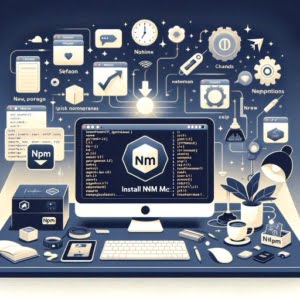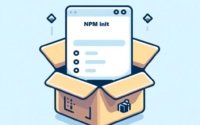Easy npm Installation on Mac | A Developer’s Guide

At IOFLOOD, we’ve encountered the challenge of installing npm on Mac systems more often than expected. To simplify this process, we’ve put together a practical guide tailored for Mac users. By following our straightforward instructions, you’ll seamlessly install npm using Homebrew, a popular package manager for macOS.
This guide will walk you through the process of installing npm on a Mac, ensuring you have access to the world of Node.js packages. Whether you’re a beginner looking to get started with JavaScript development or an experienced developer seeking to streamline your project setup, understanding how to efficiently install npm can significantly enhance your development workflow.
Let’s make installing npm on your Mac a hassle-free experience together!
TL;DR: How Do I Install npm on a Mac?
To install npm on a Mac, you can use Homebrew to install Node.js, which includes npm, with the command
brew install node.
Here’s an example:
brew install node
This command installs both Node.js and npm. For more detailed instructions and advanced setups, keep reading.
In this quick example, we use Homebrew, a package manager for macOS, to install Node.js and npm in one go. Homebrew simplifies the installation process, making it accessible even for beginners. Once the installation is complete, you have both Node.js and npm ready to use for your development projects.
Excited to dive deeper into npm and unlock its full potential? Continue reading for a comprehensive guide on installing and managing npm on your Mac.
Table of Contents
Installing npm on Mac: The Basics
For those new to the macOS terminal or programming in general, installing npm might seem like a daunting task. However, with the right tools and a bit of guidance, it’s a straightforward process. One of the simplest methods to install npm on your Mac is through Homebrew, a package manager that simplifies the installation of software on macOS.
Getting Started with Homebrew
If you haven’t installed Homebrew yet, it’s the first step you need to take. Open your Terminal and enter the following command:
/bin/bash -c "$(curl -fsSL https://raw.githubusercontent.com/Homebrew/install/HEAD/install.sh)"
# Output:
# 'Installation successful!'
This command downloads and runs the Homebrew installation script from Homebrew’s official website. Once completed, you’ll see a confirmation message indicating a successful installation.
Installing Node.js and npm
With Homebrew installed, you can now easily install Node.js, which includes npm. In your Terminal, type the following command:
brew install node
# Output:
# 'Node and npm have been installed'
This command tells Homebrew to download and install the latest version of Node.js and npm. The output message confirms the successful installation of both tools.
Remember, installing Node.js automatically installs npm since they come packaged together. This method is quick and easy, perfect for beginners who want to jump straight into their development projects.
However, it’s important to note that this approach offers limited control over the versions of Node.js and npm that are installed. For projects that require specific versions, you might need to explore more advanced installation methods, such as using nvm (Node Version Manager), which we’ll cover in the next section.
Advanced npm Installation with nvm
For developers who work on multiple projects, managing different versions of Node.js and npm can be crucial. This is where nvm (Node Version Manager) comes into play. nvm allows you to install multiple versions of Node.js and npm on your Mac, making it easy to switch between them depending on your project’s requirements.
Installing nvm on Your Mac
To get started with nvm, you first need to install it. Open your Terminal and execute the following command:
curl -o- https://raw.githubusercontent.com/nvm-sh/nvm/v0.39.1/install.sh | bash
# Output:
# 'nvm installed successfully'
This command downloads and runs the nvm installation script. After installation, you might need to close and reopen your Terminal or run the source ~/.bash_profile command to ensure nvm commands are available.
Installing Node.js and npm with nvm
With nvm installed, you can now install any version of Node.js and npm. For example, to install Node.js version 14.x and the corresponding npm version, use the following command:
nvm install 14
nvm use 14
# Output:
# 'Now using node v14.x.x (npm v6.x.x)'
This command tells nvm to download and switch to Node.js version 14.x.x. The output confirms the version of Node.js and npm now in use. Using nvm, you can install multiple versions of Node.js and npm, and switch between them as needed.
The ability to manage versions makes nvm a powerful tool for developers working on projects with different Node.js and npm version requirements. However, the setup is slightly more complex compared to the basic installation method.
By mastering nvm, you gain greater control over your development environment, allowing for a more tailored and efficient workflow. This method is particularly beneficial for intermediate-level users looking to enhance their project setup and manage multiple Node.js versions seamlessly.
Manual npm Installation: Full Control
For developers who seek the highest level of control over their development environment, manually installing npm and Node.js on a Mac offers unparalleled precision. This approach bypasses package managers like Homebrew and nvm, providing a direct route to installation. However, it’s worth noting that this method involves more steps and requires a deeper understanding of your system’s configuration.
Manually Installing Node.js and npm
To manually install Node.js and npm, you’ll first need to download the Node.js source code from the official website. After downloading, you will extract the files and compile them on your Mac. Here’s an overview of the process:
- Download the latest Node.js source from Node.js official website.
- Open Terminal and navigate to the downloaded source directory.
- Compile and install Node.js with the following commands:
cd node-vxx.xx.x
./configure
make
sudo make install
# Output:
# 'Node.js and npm installed successfully'
In this sequence, cd node-vxx.xx.x changes your directory to the one containing the Node.js source. The ./configure command prepares your system for installation. make compiles the source code into executable binaries, and sudo make install installs Node.js and npm on your system.
Setting Environment Variables
After installation, it’s crucial to set the appropriate environment variables to ensure your system recognizes the Node.js and npm binaries. Add the following lines to your .bash_profile or .zshrc file:
export PATH="/usr/local/bin:$PATH"
This command adds the Node.js and npm binary location to your system’s PATH, allowing you to run Node.js and npm commands from any terminal window.
Opting for manual installation grants you full control over the versions and configurations of Node.js and npm on your Mac. While this method offers precision, it requires a comprehensive understanding of system configurations and is best suited for expert users comfortable with command-line tools and system administration.
By choosing this path, you embrace the complexity for the sake of customization, ensuring your development environment is tailored precisely to your needs. However, remember that with great power comes great responsibility, and this method demands a meticulous approach to installation and configuration.
Even with a smooth installation process, you might encounter some common issues when installing npm on a Mac. Understanding how to troubleshoot these problems will help you maintain a productive development environment.
‘Command Not Found’ Errors
A frequent hiccup after installing npm is encountering the ‘command not found’ error when trying to run npm commands. This usually indicates that the npm binaries are not correctly added to your system’s PATH.
To add npm to your PATH, you can modify your .bash_profile or .zshrc file with the path to the npm binaries. Here’s how to locate the npm directory and add it to your PATH:
echo $PATH
/usr/local/bin:/usr/bin:/bin:/usr/sbin:/sbin
# Output:
# This is your current PATH
If /usr/local/bin (the usual location for npm binaries) is not in your PATH, you need to add it manually. Edit your .bash_profile or .zshrc file and append the following line:
export PATH="/usr/local/bin:$PATH"
After saving the changes and restarting your terminal, try running npm commands again. This adjustment should resolve the ‘command not found’ error by ensuring your system recognizes npm commands.
Permission Issues During Installation
Permission issues are another common roadblock, often manifesting as errors when trying to install packages globally without sudo. To avoid this, it’s recommended to configure npm to use a directory you own for global installations. Here’s how:
mkdir ~/.npm-global
npm config set prefix '~/.npm-global'
export PATH=~/.npm-global/bin:$PATH
# Output:
# Configures npm to use a custom directory for global installations
This sets up a dedicated directory for global npm packages and adjusts the PATH to include it. By doing so, you circumvent the need for elevated permissions when installing global packages.
Best Practices in Version Management
Managing npm versions effectively is crucial for project compatibility and stability. Using nvm, as discussed in the ‘Advanced Use’ section, allows for seamless switching between different Node.js and npm versions. Regularly updating npm ensures access to the latest features and security patches. To update npm, run:
npm install npm@latest -g
# Output:
# 'npm updated to the latest version'
This command updates npm to the latest version, keeping your development environment up to date.
Encountering issues during npm installation can be frustrating, but with these troubleshooting tips and best practices, you can ensure a smooth and efficient development workflow. Remember, understanding how to navigate these hurdles is part of becoming a proficient JavaScript developer.
npm and Node.js: Core Concepts
Before diving into the technicalities of installing npm on a Mac, it’s crucial to understand what npm is and its symbiotic relationship with Node.js. npm stands for Node Package Manager, and it’s the world’s largest software registry. Developers use npm to share and borrow packages, and many organizations also use npm to manage private development.
What is npm?
npm is a package manager for JavaScript, designed to help developers find and share software. It’s built on Node.js, which means that installing Node.js on your system also installs npm, providing you with the tools needed to manage packages for your projects. npm facilitates easy package management, allowing for the installation, updating, and removal of packages.
npm -v
# Output:
# '6.14.8'
The command npm -v simply checks the version of npm currently installed on your system. This is a basic yet essential command, as keeping npm up-to-date is crucial for accessing the latest packages and security features.
The Relationship Between npm and Node.js
Node.js is a runtime environment for executing JavaScript code outside of a browser. npm, being the package manager for Node.js, is integral for developing Node.js applications. It provides access to thousands of packages, which can significantly speed up development time and enhance functionality. The relationship between Node.js and npm is so intertwined that you cannot have npm without Node.js installed on your system.
Why is npm Essential for JavaScript Development?
npm is not just a package manager; it’s a powerful tool that has revolutionized how JavaScript developers work. It allows for the sharing and reuse of code, and its vast repository of packages means that developers can avoid ‘reinventing the wheel’ for common functionalities. This ease of sharing and updating packages fosters a vibrant ecosystem, making npm indispensable for modern JavaScript development.
The ecosystem of npm packages includes everything from small utilities to large-scale frameworks, making it a cornerstone for developers. Whether you’re working on a simple script or a complex web application, npm provides the building blocks necessary for your project. Understanding how to install and manage npm on your Mac is the first step toward tapping into this rich ecosystem.
Expanding npm Usage in Your Projects
Once you’ve mastered the basics of npm on your Mac, the next step is to leverage npm’s full potential in managing packages and automating tasks within your projects. npm is not just a tool for installing and managing external packages; it’s also a powerful ally in streamlining your development process.
Automating Tasks with npm Scripts
npm scripts are a key feature for automating repetitive tasks like testing, building, and deploying your projects. You can define scripts in your package.json file, allowing you to execute complex tasks with simple commands.
"scripts": {
"start": "node app.js",
"test": "echo \"Error: no test specified\" && exit 1"
}
In this example, the start script runs your application using node app.js, and the test script is a placeholder that prints an error message. Running npm start or npm test in your terminal executes the corresponding script.
npm scripts reduce the need for external task runners by utilizing npm’s built-in capabilities. They provide a straightforward way to automate your workflow, making your development process more efficient.
Exploring Related Tools
Beyond npm itself, the Node.js ecosystem offers a variety of tools that complement npm’s functionality. Tools like webpack for bundling your JavaScript applications, Babel for using next-generation JavaScript today, and ESLint for maintaining code quality, all play well with npm and enhance your development workflow.
Further Resources for npm Mastery
To deepen your understanding of npm and explore more advanced topics, here are three valuable resources:
- npm Documentation – The official npm documentation covers all aspects of npm, from basic usage to advanced features.
Node.js Guides – While not exclusively about npm, these offer insights on common use cases in Node.js development.
The npm Blog – For the latest news, updates, and tips from the npm team, their blog is an excellent resource.
By exploring these resources and incorporating npm scripts and related tools into your projects, you can significantly enhance your development workflow. npm is a powerful tool in your development arsenal, and mastering it opens up a world of possibilities for efficient and effective project management.
Wrapping Up: npm Installation on Mac Simplified
In this comprehensive guide, we’ve navigated the various ways to install npm on a Mac, ensuring you have the tools necessary for modern JavaScript development. From the straightforward method using Homebrew to more advanced techniques with nvm and even manual installations, we’ve covered the spectrum to suit developers at any skill level.
We began with the basics, showing how a simple Homebrew command can get you up and running with Node.js and npm. We then explored the flexibility that nvm offers, allowing developers to manage multiple Node.js versions with ease. For those seeking the utmost control, we delved into the manual installation process, providing a deep dive into custom setups.
In the journey through npm installation, we encountered common pitfalls such as ‘command not found’ errors and permission issues. We equipped you with troubleshooting tips to navigate these challenges, ensuring a smoother development experience.
| Approach | Ease of Use | Control Over Versions |
|---|---|---|
| Homebrew | High | Low |
| nvm | Moderate | High |
| Manual Installation | Low | Very High |
Whether you’re just starting out with npm or looking to refine your development setup, we hope this guide has shed light on the process and empowered you to make informed decisions.
npm is more than just a package manager; it’s a gateway to the vast ecosystem of JavaScript development. By mastering npm installation on your Mac, you unlock the potential to streamline your projects, manage dependencies efficiently, and contribute to the vibrant world of open-source software. Happy coding!

![[SOLVED]: How To Append to a List in Python? 3 Image of programmers utilizing the append and extend functions to seamlessly append items to a list in Python](https://ioflood.com/blog/wp-content/uploads/2024/06/Image-of-programmers-utilizing-the-append-and-extend-functions-to-seamlessly-append-items-to-a-list-in-Python-200x125.jpg)
